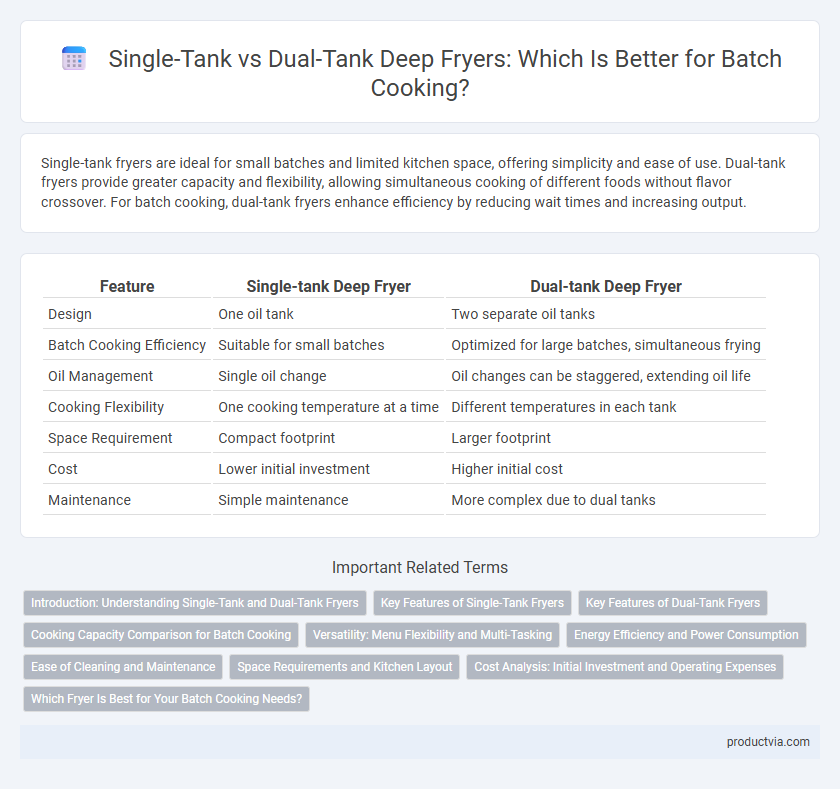Single-tank fryers are ideal for small batches and limited kitchen space, offering simplicity and ease of use. Dual-tank fryers provide greater capacity and flexibility, allowing simultaneous cooking of different foods without flavor crossover. For batch cooking, dual-tank fryers enhance efficiency by reducing wait times and increasing output.
Table of Comparison
| Feature | Single-tank Deep Fryer | Dual-tank Deep Fryer |
|---|---|---|
| Design | One oil tank | Two separate oil tanks |
| Batch Cooking Efficiency | Suitable for small batches | Optimized for large batches, simultaneous frying |
| Oil Management | Single oil change | Oil changes can be staggered, extending oil life |
| Cooking Flexibility | One cooking temperature at a time | Different temperatures in each tank |
| Space Requirement | Compact footprint | Larger footprint |
| Cost | Lower initial investment | Higher initial cost |
| Maintenance | Simple maintenance | More complex due to dual tanks |
Introduction: Understanding Single-Tank and Dual-Tank Fryers
Single-tank fryers feature one large frying compartment suitable for cookers handling moderate batch sizes, providing straightforward operation and easier maintenance. Dual-tank fryers consist of two separate frying compartments, enabling simultaneous cooking of different items or larger batch volumes, enhancing efficiency in high-demand kitchens. Choosing between single-tank and dual-tank fryers depends on cooking volume requirements, menu diversity, and kitchen workflow optimization.
Key Features of Single-Tank Fryers
Single-tank fryers provide a compact design with a single frying compartment, ideal for small to medium batch cooking where space efficiency is critical. These fryers feature a straightforward control panel for accurate temperature regulation, ensuring consistent frying results. Their simple construction allows for easier cleaning and maintenance compared to dual-tank models, making them suitable for kitchens with limited staff or lower volume needs.
Key Features of Dual-Tank Fryers
Dual-tank fryers feature two separate frying compartments, allowing simultaneous cooking of different foods at varying temperatures, which enhances efficiency in batch cooking. Each tank has independent temperature controls, providing precise heat management and reducing cross-contamination risks during frying. These fryers typically offer larger capacity and faster throughput, ideal for high-volume kitchens requiring consistent, quick preparation.
Cooking Capacity Comparison for Batch Cooking
Single-tank fryers typically offer a limited cooking capacity, making them suitable for small to medium batch cooking, whereas dual-tank fryers provide significantly greater capacity by allowing simultaneous cooking of different foods. Dual-tank fryers enhance efficiency and reduce cooking times in high-demand environments due to their ability to handle larger volumes and multiple batches. For batch cooking operations requiring versatility and higher throughput, dual-tank fryers deliver superior performance in capacity and workflow management.
Versatility: Menu Flexibility and Multi-Tasking
Single-tank fryers offer simplicity and are ideal for small to medium batch cooking with limited menu options, making them perfect for focused frying tasks. Dual-tank fryers enhance versatility by allowing simultaneous cooking of multiple items, enabling diverse menu options and efficient multitasking in busy kitchens. This flexibility supports frying different foods at various temperatures, improving overall kitchen productivity and menu variety.
Energy Efficiency and Power Consumption
Single-tank fryers typically consume less power than dual-tank fryers, making them more energy-efficient for smaller batch cooking tasks. Dual-tank fryers offer the advantage of cooking two different items simultaneously but generally use more energy due to heating multiple oil reservoirs. Choosing between single and dual-tank fryers depends on batch size and frequency, with single-tank models favored for lower power consumption during limited batch cooking.
Ease of Cleaning and Maintenance
Single-tank fryers offer simpler cleaning processes due to fewer components and less oil volume, reducing downtime between batches. Dual-tank fryers require more extensive cleaning routines as each tank must be drained, scrubbed, and maintained separately, increasing labor and maintenance time. Choosing a single-tank fryer can enhance operational efficiency by minimizing cleaning complexity and maintenance efforts during batch cooking.
Space Requirements and Kitchen Layout
Single-tank fryers occupy less space and are ideal for compact kitchens with limited countertop area, making them suitable for small batch cooking and simple kitchen layouts. Dual-tank fryers require more space due to their larger footprint but offer greater flexibility by allowing simultaneous cooking of different foods, improving efficiency in busy kitchens designed for higher volume batch cooking. Considering kitchen layout, dual-tank models demand adequate ventilation and workspace separation to optimize workflow and ensure safety.
Cost Analysis: Initial Investment and Operating Expenses
Single-tank fryers typically have a lower initial investment cost, making them more suitable for small-scale batch cooking and businesses with budget constraints. Dual-tank fryers, while requiring a higher upfront cost, offer greater efficiency in large-scale operations by reducing frying time and energy consumption through simultaneous cooking. Operating expenses for dual-tank fryers can be lower over time due to improved productivity and reduced labor costs, offsetting the initial investment difference.
Which Fryer Is Best for Your Batch Cooking Needs?
A single-tank fryer offers simplicity and faster heat recovery, ideal for small to medium batch cooking with limited space. Dual-tank fryers provide greater flexibility and efficiency for large-scale batch cooking, allowing simultaneous frying of different foods without flavor transfer. Choosing between them depends on your batch size, cooking frequency, and kitchen capacity.
Single-tank fryer vs Dual-tank fryer for batch cooking Infographic

 productvia.com
productvia.com